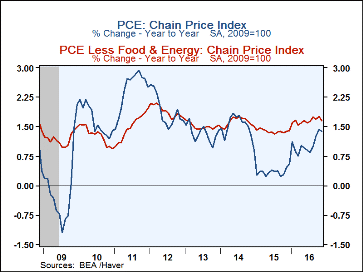 Global| Dec 22 2016
Global| Dec 22 2016U.S. Personal Income & Spending Growth Soften
by:Tom Moeller
|in:Economy in Brief
Summary
Personal income remained unchanged during November (3.5% y/y) following a 0.5% October rise, revised from 0.6%. A 0.3% increase had been expected in the Action Economics Forecast Survey. Disposable personal income eased negligibly [...]
Personal income remained unchanged during November (3.5% y/y) following a 0.5% October rise, revised from 0.6%. A 0.3% increase had been expected in the Action Economics Forecast Survey. Disposable personal income eased negligibly (+3.7% y/y) after a 0.5% rise. Adjusted for higher prices, take-home pay slipped 0.1% (+2.3% y/y), the weakest figure since March 2015.
Wages & salaries slipped 0.1% (+3.5% y/y) after two months of firm increase. Receipts on assets improved 0.2% (2.5% y/y) after a 0.5% rise. Rental income gained 0.9% (6.5% y/y), the same as in October. Proprietors' income improved 0.3% (2.8% y/y) after a 0.2% gain. Transfer receipts fell 0.2% (+3.5% y/y), reflecting a 1.0% decline (+2.8% y/y) in Social Security payments which reversed the prior month's rise. Medicare payments rose 0.3% (5.0% y/y) for the fifth straight month. Medicaid receipts improved 0.4% (6.0% y/y). Unemployment insurance benefits declined 0.4% (-9.8% y/y) with the improved job market.
Personal consumption expenditures increased 0.2% (4.2% y/y) following a 0.4% October rise, revised from 0.3%. A 0.3% November increase had been expected in the Action Economics Forecast Survey.
Adjusted for higher prices, spending rose 0.1% (2.8% y/y) after a 0.1% increase. Real durable goods spending eased 0.1% (+6.9% y/y) as real motor vehicle purchases declined 1.5% (+5.7% y/y) after a 1.8% rise. Constant dollar home furnishings & appliance spending increased 1.3% (6.7% y/y) after a 0.3% dip. Real spending on recreational goods & vehicles rose 1.0% (12.2% y/y). Real nondurable goods purchases increased 0.2% (2.6% y/y) as eating out expenditures rose 0.6% (5.4% y/y) after a 1.1% jump. Real clothing purchases rose 0.5% (1.3% y/y) following a 0.1% dip. Real services outlays increased 0.2% (2.3% y/y) and reversed the October decline. A 0.7% increase (2.5% y/y) in restaurant & accommodations spending led the increase after a 0.8% fall. A 0.2 % fall (+0.2% y/y) in recreation services outlays was accompanied by a 0.1% improvement (3.8% y/y) in health care outlays for a second straight month.
The personal savings rate declined to 5.5%, off marginally from the previous two months. The level of personal savings declined 4.4% y/y.
The chain price index remained unchanged (1.4% y/y) after a 0.3% rise, while excluding food & energy prices it also was unchanged (1.6% y/y) following two months of 0.1% increase. A 2.2% increase (0.7% y/y) in gasoline prices followed two months of stronger increases. Clothing prices offset some of this rise with a 0.5% decline (-0.2% y/y). Food & beverage costs also eased 0.2% (-1.7% y/y). The durable goods price index fell 0.5% (-2.5% y/y) after little change. A 0.8% decline in recreational goods prices (-6.8% y/y) continued several months of decline. The services price index increased 0.1% (2.4% y/y) after nine consecutive months of 0.2% increase.
The personal income & consumption figures are available in Haver's USECON database with detail in the USNA database. The Action Economics figure is in the AS1REPNA database. Further detail is in USNA.
| Personal Income & Outlays (%) | Nov | Oct | Sep | Nov Y/Y | 2015 | 2014 | 2013 |
|---|---|---|---|---|---|---|---|
| Personal Income | 0.0 | 0.5 | 0.4 | 3.5 | 4.4 | 5.2 | 1.1 |
| Wages & Salaries | -0.1 | 0.5 | 0.4 | 3.5 | 5.1 | 5.1 | 2.7 |
| Disposable Personal Income | -0.0 | 0.5 | 0.3 | 3.7 | 3.8 | 5.1 | -0.1 |
| Personal Consumption Expenditures | 0.2 | 0.4 | 0.7 | 4.2 | 3.5 | 4.4 | 2.8 |
| Personal Saving Rate | 5.5 | 5.7 | 5.6 | 6.0 (Nov '15) |
5.8 | 5.6 | 5.0 |
| PCE Chain Price Index | 0.0 | 0.3 | 0.2 | 1.4 | 0.3 | 1.5 | 1.3 |
| Less Food & Energy | 0.0 | 0.1 | 0.1 | 1.6 | 1.4 | 1.6 | 1.5 |
| Real Personal Consumption Expenditures | 0.1 | 0.1 | 0.5 | 2.8 | 3.2 | 2.9 | 1.5 |
| Real Disposable Income | -0.1 | 0.2 | 0.1 | 2.3 | 3.5 | 3.5 | -1.4 |
Tom Moeller
AuthorMore in Author Profile »Prior to joining Haver Analytics in 2000, Mr. Moeller worked as the Economist at Chancellor Capital Management from 1985 to 1999. There, he developed comprehensive economic forecasts and interpreted economic data for equity and fixed income portfolio managers. Also at Chancellor, Mr. Moeller worked as an equity analyst and was responsible for researching and rating companies in the economically sensitive automobile and housing industries for investment in Chancellor’s equity portfolio. Prior to joining Chancellor, Mr. Moeller was an Economist at Citibank from 1979 to 1984. He also analyzed pricing behavior in the metals industry for the Council on Wage and Price Stability in Washington, D.C. In 1999, Mr. Moeller received the award for most accurate forecast from the Forecasters' Club of New York. From 1990 to 1992 he was President of the New York Association for Business Economists. Mr. Moeller earned an M.B.A. in Finance from Fordham University, where he graduated in 1987. He holds a Bachelor of Arts in Economics from George Washington University.










